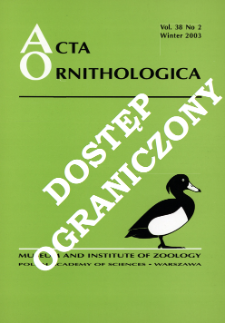- Wyszukaj w całym Repozytorium
- Piśmiennictwo i mapy
- Archeologia
- Baza Młynów
- Nauki przyrodnicze
Wyszukiwanie zaawansowane
Wyszukiwanie zaawansowane
Wyszukiwanie zaawansowane
Wyszukiwanie zaawansowane
Wyszukiwanie zaawansowane

Obiekt
Tytuł: Male colour type and lifetime breeding success in the pied flycatcher Ficedula hypoleuca
Twórca:
Ivankina, Elena Vasil'evna ; Grinkov, Vladimir G. ; Kerimov, Anvar Burhanovič (1955– )
Data wydania/powstania:
Typ zasobu:
Inny tytuł:
Acta Ornithologica, vol. 36, no. 1 ; Typ ubarwienia a sukces lęgowy u samców muchołówki żałobnej ; Male colour brightness and lifetime breeding success in pied flycatcher
Współtwórca:
Polska Akademia Nauk. Muzeum i Instytut Zoologii ; Meeting of the European Ornithologists' Union (2 ; 1999 ; Gdańsk)
Wydawca:
Muzeum i Instytut Zoologii PAN
Miejsce wydania:
Opis:
Referat wygłoszony na Second Meeting of the European Ornithologists' Union ; Bibliogr. s. 95 ; S. [91]-96 : il. ; 27 cm ; Streszcz. pol.
Typ obiektu:
Abstrakt:
The lifetime breeding success of male Pied Flycatchers was evaluated over a period of nine years (1991-99). The breeding success of males recorded in at least two breeding seasons and nesting at least once in the study area was analysed. The lifespan number of offspring was positively and significantly correlated with longevity. The reproductive investment in the first year of life did not correspond with longevity, and hence non-breeding males in the first year did not compensate for the losses in fecundity. There were no differences in longevity between dark, intermediate and female-like coloured males. Darker males were less successful in their breeding attempts in the first year than paler birds. Breeding in the first year of life positively influenced the future number of fledglings, and the greater investment in reproduction in this year positively affected future brood size in dark males. Among males successfully breeding in the study area from their first season, dark males reared significantly more offspring during their lifetime, and in the first year of life, than paler ones. Nevertheless, in the total sample, lifetime brood size did not vary between differently coloured males, perhaps because dark males are more vulnerable to predators. The general difference between differently coloured males lay in how breeding efforts were distributed during life. Dark males can maximise reproductive investment from the first breeding year, while paler males increased average brood size in the following years of life only.
Czasopismo/Seria/cykl:
Tom:
Zeszyt:
Strona pocz.:
Strona końc.:
Szczegółowy typ zasobu:
Artykuł ; Materiały konferencyjne
Format:
Identyfikator zasobu:
Źródło:
MiIZ PAN, patrz sygn. czas. P.257, Vol. 36, No ; MiIZ PAN, patrz sygn. czas. P.4568, Vol. 36, No 1 ; kliknij tutaj, żeby przejść
Język:
Prawa:
Prawa zastrzeżone - dostęp ograniczony
Zasady wykorzystania:
Digitalizacja:
Muzeum i Instytut Zoologii Polskiej Akademii Nauk
Lokalizacja oryginału:
Biblioteka Muzeum i Instytutu Zoologii PAN
Dofinansowane ze środków:
Program Operacyjny Innowacyjna Gospodarka, lata 2010-2014, Priorytet 2. Infrastruktura strefy B + R ; Unia Europejska. Europejski Fundusz Rozwoju Regionalnego
Dostęp:
Kolekcje, do których przypisany jest obiekt:
- Repozytorium Cyfrowe Instytutów Naukowych > Kolekcje Partnerów > Muzeum i Instytut Zoologii PAN > Czasopisma
- Repozytorium Cyfrowe Instytutów Naukowych > Kolekcje Partnerów > Muzeum i Instytut Zoologii PAN > Wydawnictwa MiIZ PAN > Acta Ornithologica
- Repozytorium Cyfrowe Instytutów Naukowych > Piśmiennictwo > Czasopisma/Artykuły
Data ostatniej modyfikacji:
4 lut 2025
Data dodania obiektu:
23 maj 2014
Liczba pobrań / odtworzeń:
92
Wszystkie dostępne wersje tego obiektu:
https://rcin.org.pl./publication/61304
Wyświetl opis w formacie RDF:
Wyświetl opis w formacie RDFa:
Wyświetl opis w formacie OAI-PMH:
| Nazwa wydania | Data |
|---|---|
| Male colour type and lifetime breeding success in the pied flycatcher Ficedula hypoleuca / Ivankina, Elena Vasil'evna | 4 lut 2025 |
Obiekty Podobne
Il'ina, Tat'âna Aleksandrovna Ivankina, Elena Vasil'evna
Dunajewski, Andrzej (1908–1944)
Tilgar, Vallo (1973– ) Mänd, Raivo (1954– ) Leivits, Agu
Walankiewicz, Wiesław Mitrus, Cezary Czeszczewik, Dorota Jabłoński, Piotr M.
Pruska, Małgorzata
Walankiewicz, Wiesław Mitrus, Cezary
Salvati, Luca Manganaro, Alberto Ranazzi, Lamberto
Dunajewski, Andrzej (1908–1944)

 INSTYTUT ARCHEOLOGII I ETNOLOGII POLSKIEJ AKADEMII NAUK
INSTYTUT ARCHEOLOGII I ETNOLOGII POLSKIEJ AKADEMII NAUK
 INSTYTUT BADAŃ LITERACKICH POLSKIEJ AKADEMII NAUK
INSTYTUT BADAŃ LITERACKICH POLSKIEJ AKADEMII NAUK
 INSTYTUT BADAWCZY LEŚNICTWA
INSTYTUT BADAWCZY LEŚNICTWA
 INSTYTUT BIOLOGII DOŚWIADCZALNEJ IM. MARCELEGO NENCKIEGO POLSKIEJ AKADEMII NAUK
INSTYTUT BIOLOGII DOŚWIADCZALNEJ IM. MARCELEGO NENCKIEGO POLSKIEJ AKADEMII NAUK
 INSTYTUT BIOLOGII SSAKÓW POLSKIEJ AKADEMII NAUK
INSTYTUT BIOLOGII SSAKÓW POLSKIEJ AKADEMII NAUK
 INSTYTUT CHEMII FIZYCZNEJ PAN
INSTYTUT CHEMII FIZYCZNEJ PAN
 INSTYTUT CHEMII ORGANICZNEJ PAN
INSTYTUT CHEMII ORGANICZNEJ PAN
 INSTYTUT FILOZOFII I SOCJOLOGII PAN
INSTYTUT FILOZOFII I SOCJOLOGII PAN
 INSTYTUT GEOGRAFII I PRZESTRZENNEGO ZAGOSPODAROWANIA PAN
INSTYTUT GEOGRAFII I PRZESTRZENNEGO ZAGOSPODAROWANIA PAN
 INSTYTUT HISTORII im. TADEUSZA MANTEUFFLA POLSKIEJ AKADEMII NAUK
INSTYTUT HISTORII im. TADEUSZA MANTEUFFLA POLSKIEJ AKADEMII NAUK
 INSTYTUT JĘZYKA POLSKIEGO POLSKIEJ AKADEMII NAUK
INSTYTUT JĘZYKA POLSKIEGO POLSKIEJ AKADEMII NAUK
 INSTYTUT MATEMATYCZNY PAN
INSTYTUT MATEMATYCZNY PAN
 INSTYTUT MEDYCYNY DOŚWIADCZALNEJ I KLINICZNEJ IM.MIROSŁAWA MOSSAKOWSKIEGO POLSKIEJ AKADEMII NAUK
INSTYTUT MEDYCYNY DOŚWIADCZALNEJ I KLINICZNEJ IM.MIROSŁAWA MOSSAKOWSKIEGO POLSKIEJ AKADEMII NAUK
 INSTYTUT PODSTAWOWYCH PROBLEMÓW TECHNIKI PAN
INSTYTUT PODSTAWOWYCH PROBLEMÓW TECHNIKI PAN
 INSTYTUT SLAWISTYKI PAN
INSTYTUT SLAWISTYKI PAN
 SIEĆ BADAWCZA ŁUKASIEWICZ - INSTYTUT TECHNOLOGII MATERIAŁÓW ELEKTRONICZNYCH
SIEĆ BADAWCZA ŁUKASIEWICZ - INSTYTUT TECHNOLOGII MATERIAŁÓW ELEKTRONICZNYCH
 MUZEUM I INSTYTUT ZOOLOGII POLSKIEJ AKADEMII NAUK
MUZEUM I INSTYTUT ZOOLOGII POLSKIEJ AKADEMII NAUK
 INSTYTUT BADAŃ SYSTEMOWYCH PAN
INSTYTUT BADAŃ SYSTEMOWYCH PAN
 INSTYTUT BOTANIKI IM. WŁADYSŁAWA SZAFERA POLSKIEJ AKADEMII NAUK
INSTYTUT BOTANIKI IM. WŁADYSŁAWA SZAFERA POLSKIEJ AKADEMII NAUK




































